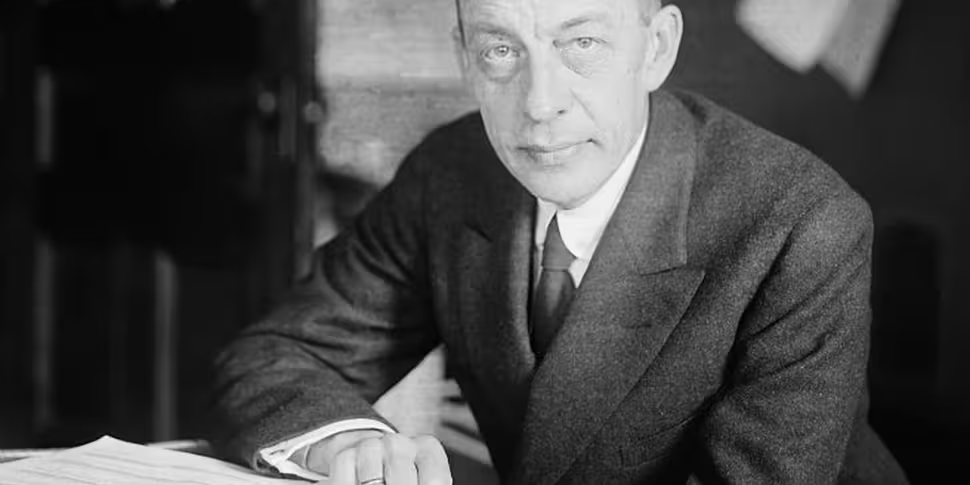The dissolution of the USSR in the late 1980s and early 90s brought massive changes to the nations that had lived behind the ‘Iron Curtain’ for so long. The cultural shock resulting from the return to capitalism was particularly acute in Russia, which had been defined by communism since the revolutions of 1917. Not only was this giant nation now open to the flow of ideas from the previously closed off ‘West’ but it was also free to delve into the history and culture from Tsarist Russia, for so long censored by the Communist Party.
One figure re-assimilated in Russia’s post-communist cultural re-appropriation was the pianist and composer Sergei Vasilyevich Rachmaninoff. Whose traditionally inspired Russian music made him internationally famous during communist rule and a beacon for his fellow emigrants. His works are now taught and played across the homeland he was forced to flee almost a century ago.
Born to one of Russia’s oldest aristocratic families and a leading figure of the very bourgeois Russian Romanticism there was little or no place in Soviet Russia for Rachmaninoff. After the second revolution came in October 1917 and the Bolsheviks took power Rachmaninoff knew that his life in his homeland was at an end. Two months later he reluctantly left Russia for Helsinki in an open sled with his wife, two daughters, and a few precious possessions.
Forced to leave behind the career and reputation he had built up in Russian society Rachmaninoff had to face into an unknown future as a refugee in America and Europe. Most difficult of all though, he was forced to leave behind the nation he loved so much. In his years abroad, however, Rachmaninoff would become a key figure in the Russian émigré community as his music echoed and kept alive the 19th century Russian romantic style. This isn’t surprising, however, when we consider his youth.
Born into a wealthy aristocratic family in 1873 Rachmaninoff was probably expected to follow in the family’s military tradition. His father’s financial mismanagement, however, put the final nail in the family’s dwindling fortunes. In 1883, after the family had sold their last estate and moved to a flat in Saint Petersburg, Rachmaninoff was enrolled in the musical school, Saint Petersburg Conservatory, and his father left the family to the mutual consent of all.
Both of these events proved instrumental to the development of Rachmaninoff as a musician and composer. Whereas before he had been thought at home by a private teacher, now he was in an environment rich in the varied and vying music in which Russia found itself awash. Though the Saint Petersburg Conservatory focused more on the classical schools of music the other defining influence from this time came from his maternal grandmother.The year his father left for Moscow Rachmaninoff’s sister Sofia died and his grandmother joined the family to aid her daughter in raising the children. A devout Christian Rachmaninoff’s grandmother’s main interest was in the spiritual lives and wellbeing of her grandchildren. To this end she regularly brought Sergei and his siblings to church services. The chanted liturgies, devotional music, and ringing of the church bells used in these Russian Orthodox services had a strong influence on the young Sergei Rachmaninoff and their reverberations can be heard in his musical compositions.
After only a few years in Saint Petersburg Rachmaninoff’s older sister Yelena passed away. In reaction to this second loss his grandmother withdrew to a farm on the Volkhov River with Rachmaninoff in tow. This period of respite proved extremely detrimental to Rachmaninoff’s studies and he struggled to pass his school exams after returning to school. Though this falloff in academic performance is sometimes attributed to his grandmother’s pampering Rachmaninoff had also lost two sisters and seen the breakdown of his family unit and way of life in the space of a few years.
Despite his clear natural talent for music, which saw him play at important events for the Conservatory, Rachmaninoff’s place at the school seemed untenable. His mother consulted with her nephew, the accomplished pianist Alexander Siloti, and it was decided that the Moscow Conservatory and the musical atmosphere and thought there would suit Rachmaninoff much better. They weren’t to be disappointed as over the following six years Rachmaninoff’s musical talent blossomed under the tutelage of Tchaikovsky and others.In 1891 he graduated with honours from the Moscow Conservatory and moved in with Siltoi, and both men began to play and compose in earnest. Though he wrote some short symphonic pieces during his last years of school Rachmaninoff completed his first opus after leaving college. This Piano Concerto No. 1 was dedicated to Siloti who had been so important to Rachmaninoff’s musical development and education.
The following year Rachmaninoff performed his first independent concert and put the final touches to the last of his works for the Moscow Conservatory. This short opera, called Aleko, met with resounding success and earned Rachmaninoff a number of awards and accolades, including being performed by the world famous Bolshoi Theatre. Today this work continues to be performed and be met by critical acclaim.
In the years after his graduation Rachmaninoff established his musical reputation across Russia and Europe. It was while on one of these tours in Europe that he heard of the sudden death of Tchaikovsky in 1893. Quickly returning to Russia Rachmaninoff immediately began to pen a requiem for his friend and teacher. Far more melancholic than his previous works Trio Élégiaque No. 2 marked a shift in Rachmaninoff’s work toward the more sombre.This profound loss would be compounded four years later after his First Symphony was poorly received by critics, with some vitriolically blasting the piece. These criticisms hurt Rachmaninoff deeply and he fell into a depression that would shadow him for at least three years. During this period Rachmaninoff’s musical output ceased all together. This period did, however, see him become engaged to his cousin Natalia, though the marriage was strongly opposed by their families and the church.
The 20th century, however, would see a change in Rachmaninoff’s fortunes. With the aid of Dr Nikolai Dahl he was able to overcome his creative block and he wrote the excellently received Piano Concerto No. 2 in 1901, which he dedicated to Dr Dahl. Furthermore, Rachmaninoff and Natalia were able to circumvent the church’s refusal to marry them and were wed on April 29th 1902. This return to form saw Rachamaninoff’s star quickly rise and in the ensuing years he was conductor of the Bolshoi Theatre, composed numerous works, and had his first tour of the United States.
Sadly this good fortune wasn’t to last as the Russian Revolutions swept away the life and career Rachmaninoff and his family had built for themselves.Though hesitant to go, the United States offered Rachmaninoff the best opportunity to start afresh. In 1918 the Rachmaninoff’s joined so many of the other Russian emigrants making a new life in the New World. His fantastic music memory and clear and distinct playing style soon made Rachmaninoff one of the world’s most famous pianists. His creative flow was, however, badly affected by the separation from his homeland and his busy concert schedule.
Rachmaninoff attempted to replicate pre-Revolutionary Russia in his new life abroad. His new home in the United States was decorated in Russian style and the family employed Russian servants and maintained Russian traditions and customs. Rachmaninoff also went out of his way to befriend fellow exiled Russian musicians. The animosity Rachmaninoff felt toward those he felt had driven him from Russia culminated in 1931 when he added his name to a letter condemning the ruling Russian regime.
This letter seems to have acted as a milestone in Rachmaninoff’s life abroad as his composition work took off once again. Though this reinvigoration may also be due to the acquisition of a Swiss lakeside cabin which was said to be very reminiscent of his home in Russia. Whatever the case was the next decade saw Rachmaninoff complete his final four major works, including Symphony No 3 and the famous Variations on a Theme of Corelli. He also returned to conducting at the end of 1939 after an almost thirteen year absence.This final full return to form was sadly cut short after he fell ill while on tour in 1942. He was diagnosed with diagnosed with acute melanoma and wasn’t expected to live for very long. On February 1st the following year both Rachmaninoff and his wife were made citizens of the United States. Sixteen days later, on February 17th 1943, he gave his last recital. On March 28th 1943, just four days shy of his 70th birthday, Sergei Rachmaninoff passed away.
Remembered today for the fantastic clarity of his playing Rachmaninoff is regarded as one of the greatest pianists of history. His legacy and impact as a composer are, however, far greater. With his roots in Russian Romanticism Rachmaninoff brought whole musical worlds together as he branched out into the modern period and the wider world. His compositions and musical performances helped to bring the music of pre-Revolutionary Russia to the wider world and preserve it until the 'Iron Curtain' fell.
Listen back as ‘Talking History’ travels through the life of Sergei Rachmaninoff. From grand estates under Tsarist rule to exile in the wake of the Bolshevik Revolution we find out what drove this man to create such wonderful pieces of music. Together with a panel of historians and musicians Patrick delves into the life of this great man who has inspired artists from the piano work of Oscar Peterson and Muse to the now infamous protest song of Pussy Riot.









